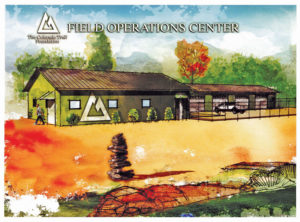By George Sibley
Colorado has now had a state water plan long enough (half a year) for critical commentary to crank up.
The main criticism seems to be that the water plan is “not a plan at all, but just a lot of ideas and suggestions” for better water use. The critics seem to want a twelve-step program to follow, one step at a time, for meeting a mid-century gap between an unknown demand and an unknown supply, but there are just too many things we don’t know for sure but must try to prepare for. Will the 2050 population be 50, 75, or 100 percent higher? And how much of the increase will be in the metropolitan areas, and how much in places like Salida and Gunnison?
Even more uncertain is how much water we will even have by mid-century. We know that the climate is changing around us – consistently warmer temperatures year round, earlier runoffs and runoffs no longer predictable from historic snowpack comparisons. We don’t know what will happen with precipitation by mid-century, but higher temperatures are a certainty, which means more evaporation, so even the same amount of water will not go so far. Already in the Colorado River Basin, average river flows from 1990 to the present are down about ten percent from 20th century averages.
So the water plan is, yes, a collection of ideas and suggestions for ways to use whatever water we have more efficiently and effectively. But beyond that, the water plan also attempts to establish frameworks for important conversations about water use – especially conversations across Colorado’s great divides. One such divide is the Continental Divide. Any further trans-mountain diversion ideas will be discussed within the plan’s framework of seven points that all Colorado river basins signed off on – however reluctantly. These are points about when and under what conditions such diversions could happen, who would assume the risk of maybe only getting project water one or two years in ten and what mitigations would have to be made for basins of origin. Some water mavens say the seven points preclude any further trans-mountain diversions; they certainly suggest major desperation on the part of would-be diverters.
But the more complex divide for which the plan tries to establish a framework for conversation is the historical urban-rural, city-farm divide. Most of whatever new population arrives will be joining the 90 percent-plus of the state’s population living in the metropolitan and micropolitan areas (like Montrose or Fremont Counties). Future water needs of new urban dwellers are what motivated the planning process. And where will the water they need come from? Some of it will come from urban conservation. A little more will come through the existing trans-mountain tunnels, in good water years, if the Front Range builds storage for it.
But the rest of it will come from agriculture, because there is simply nowhere else to get it renewably. Does this mean that the cities will be drying up the farms and ranches? That’s the fear the media keep trying to drum into us: the buy-and-dry syndrome! The media create the impression that the cities are sending out Mafia types with blackjacks to offer farmers a “deal they can’t refuse,” and when the cities get their water, there will be no more farms and ranches!
But the math here is interesting. The 90 percent of the people who live in Colorado’s urban areas currently use around eight percent of Colorado’s water. The two percent of the people who live and work on farms and ranches use 85 percent of Colorado’s water. So if the urban demand were to double by mid-century (unlikely), the quantity needed would be roughly equivalent to 10-15 percent of the agricultural water.
Could the ranchers and farmers in these Central Colorado valleys stay in business if 15 percent of their water was redirected to the cities? Probably, with some serious efficiency measures like lining or piping old ditches, and conservation actions like fallowing fields or finding less water-intensive crops. But all of these things either cost money or lose it, and take already stressed time and energy to implement. Some of the measures to free up water cause injury to other users who depend on quantity and timing of return flows. There is no end of reasonable arguments against doing what would need to be done to make that water available to the cities on the farmers’ terms. This includes one argument I’m hearing as we try to initiate local thinking on this challenge in the Upper Gunnison: “What we’re doing has worked for 130 years, through all kinds of ups and downs; why should we start worrying about alternatives now?”
There are two reasons why. One is that the cities will be definitely be coming to agriculture for water because there is simply no other renewable source. And the second reason for starting to act on that threat or promise is because the cities know they will have to pay for that water – the way California’s coastal cities are already paying farmers in the Imperial and Palo Verde valleys for water freed up through fallowing, efficiencies, and other measures.
[InContentAdTwo] Just as it lays out a framework for future conversations between the West Slope and the Front Range on trans-mountain diversions, the Colorado Water Plan lays out the framework for a new contract between the city and the ag community. “Alternate Transfer Methods” – alternatives to “buy-and-dry” – are discussed in Chapter 6.4 of the Water Plan.*
I don’t want to go into the specific “ATMs” here; instead I want to challenge all of us – not just the ranchers – in the headwaters valleys of Central Colorado to get serious about exploring the true value of an acre-foot of agricultural water here. The fact is our farmers and ranchers are currently providing a lot of services to us and to the entire river basins below the headwaters with no reimbursement at all, and this should be part of that conversation across the urban-rural divide.
It is not too difficult to put a dollar figure on the quantity of hay an acre-foot of water produces in the headwaters, where hay is often the most logical crop due to growing season, field slope, soil quality and other ag factors.
But what is the value of that acre-foot of water in maintaining the open space that is so valued in our tourism/resort economies in these valleys? And what is the value to the recreational as well as the ag economies of the delayed flows that come from spreading the two-month spring floods over the floodplains and benches, with groundwater return flows maintaining the late summer and fall streams?
George Whitten, a savvy old San Luis Valley rancher, and several other speakers at this summer’s Water Workshop at Western spoke of the headwaters grazing lands as a “sponge” that should be kept as full of water as possible, our most affordable short-term storage. The Nature Conservancy is currently working here in the Upper Gunnison on a project to repair gullied headwaters meadows, restoring a higher water table to turn sagebrush drylands to grassy wet meadows.
Lynn Cudlip, a Gunnison hydrologist, catalogued the ecosystem services that come from flood irrigation of hayfields and grass meadows in the headwaters:
“Some ecosystem services related to water include water purification and storage, wildlife habitat maintenance, stream stabilization, groundwater recharge and discharge and carbon sequestration. Gunnison basin’s flood irrigation leads to development of wetlands which have extensively expanded those ecosystem services …(but) we have not quantified these other services these irrigated hay meadows provide. … Any new water supply project which would reduce the amount of irrigated land should be evaluated for its impact to these ecosystem services.”
The farmers and ranchers maintain all these ecosystem services for us without reimbursement, in part because no one knows what the true costs are. How do we put a price on the priceless?
But Cudlip mentions carbon sequestration, an important part of the effort to keep carbon-based climate disruption in check, and we are beginning to pin down the value of a ton of carbon sequestered. There are other costs and benefits associated with the use of agricultural water that we could be measuring. If a hayfield is fallowed, what is the cost to the rancher – and what are the costs and benefits to the whole local economy? What are the short-term costs and long-term benefits of piping a ditch? These kinds of things could be somewhat quantified through well-designed studies, if we would just get on it.
What needs to be faced is the inevitability of this conversation across the urban-rural divide, and the present desire of the cities to transcend the heritage of smoldering bad vibes. The cities know that people have to have food to eat as well as water to drink, and they do not like “buy-and-dry” any more than the ranch communities do. They all actually have lists of names of farmers and ranchers who have approached them about selling their water, but they want solutions that obtain the needed 15 percent or so of agricultural water while sustaining the agriculture, and they are willing to put money into that.
How much money is the question that will drive a lot of the conversation, and it would be a lot more proactive for the farmers and ranchers to go to the table with some substantiated figures in hand, including all those free ecosystem services, rather than, as usual, letting the cities set the prices for everything. The question is whether we are willing to cross that greater divide.
George Sibley lives and writes in Gunnison, and likes to hear from readers – george@gard-sibley.org.


